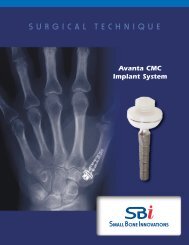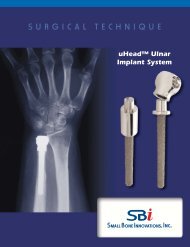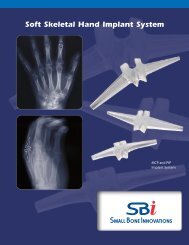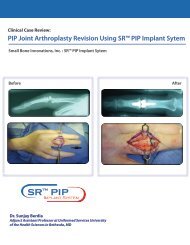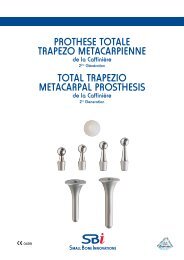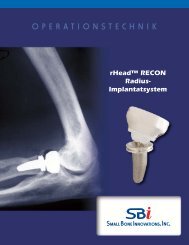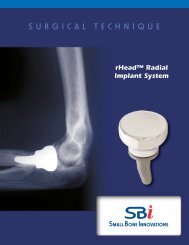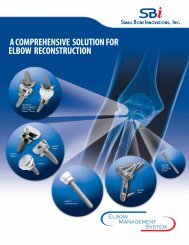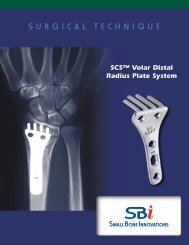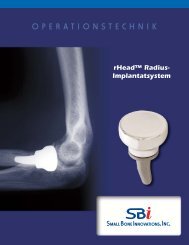PGT INSTRUmENTATIoN - Small Bone Innovations
PGT INSTRUmENTATIoN - Small Bone Innovations
PGT INSTRUmENTATIoN - Small Bone Innovations
You also want an ePaper? Increase the reach of your titles
YUMPU automatically turns print PDFs into web optimized ePapers that Google loves.
Placement of the Tibial Alignment Guide<br />
A 3.2 mm self drilling pin is inserted into the anterior tibial<br />
tubercle and perpendicular to the long axis of the tibia. The proximal<br />
portion of the tibial alignment guide is positioned over this fixation<br />
pin and the superior screw on the guide is tightened, locking the<br />
tibial alignment guide superiorly. The tibial cutting guide is positioned<br />
on an adjustable bar. (FIGURE 3) The guide is extended half of<br />
the length of the bar to allow for proximal and distal adjustments<br />
depending upon how much of the plafond requires resection. The<br />
distal aspect of the tibial alignment guide is positioned on the bar<br />
approximately 5 mm proximal to the tibial plafond. (This will allow a<br />
cut just proximal to the proximal extent of the articular surface.)<br />
A T Guide can be inserted into the cutting block to aid in assessing<br />
the rotational and varus/valgus orientation of the tibial cutting<br />
guide (FIGURE 3). An osteotome can also be placed along the medial<br />
gutter of the ankle joint to aid in visualization when setting proper<br />
rotational orientation of the guide. Attach the parallel alignment rod<br />
to the midportion of the tibial alignment guide to confirm that the<br />
tibial alignment guide is parallel to the tibial diaphysis in both A/P<br />
and lateral planes with use of the C-arm (FIGURE 3). The distal portion<br />
of the alignment guide is secured with the use of 2.4 mm drill<br />
pins. The level of the tibial resection is checked with the use of the<br />
angel wing (FIGURES 4, 5, 6).<br />
T Guide<br />
Parallel alignment rod<br />
Figure 3<br />
Figure 4<br />
Figure 5<br />
The angel wing is placed in the cutting slot of the tibial resection<br />
guide to set the cutting guide for a mimimum of 5mm distal tibial<br />
resection. There are 7 pegs each extending 5 mm from the central<br />
blade of the angel wing that are used to guage the amount of tibial<br />
resection. For reference, the pegs are spaced every 10 mm’s.<br />
The inferior tip of the closest peg is adjusted (using C-arm lateral<br />
view) to align with the most superior aspect of the distal tibial<br />
plafond (FIGURE 5). This adjustment is made by using the gear key<br />
on the tibial cutting guide, dialing it distal or proximal. The set screw<br />
is then tightened to lock the guide prior to cutting. (In very loose<br />
ankle joints, there may be increased ability to distract the talus<br />
inferiorly. In this case, the surgeon may choose to remove only<br />
4mm of bone from the distal tibia. With a very tight ankle joint,<br />
where there is little ability to distract the talus distalward, one<br />
may need to resect 6 or 8 mm of distal tibial bone.)<br />
10 mm increments<br />
Angel Wing<br />
Figure 6<br />
6<br />
S.T.A.R. ® Scandinavian Total Ankle Replacement Surgical Technique



